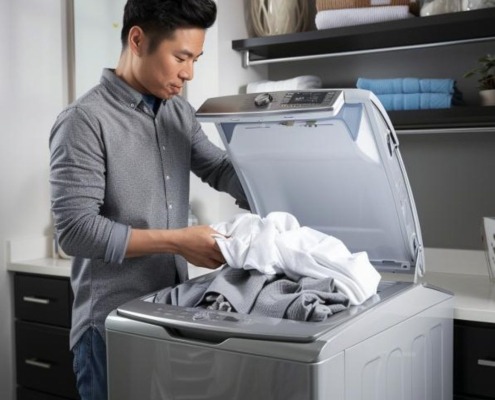How to Troubleshoot Whirlpool Washer Error Code F13
Steven E / Thursday May 8, 2025
Having trouble getting your Whirlpool front-load washer to dispense detergent properly? Seeing an F13 or “dispenser error” code appear on your display? Don’t worry – this issue can often be resolved with some simple troubleshooting steps. We’ll walk through how to diagnose and fix an F13 whirlpool washer error code.
If you find out that you need any replacement parts for your appliance while you’re troubleshooting, you can enter your model number at AppliancePartsPros.com to order them. Most orders arrive in just two business days, and we have thousands of free guides to show you how to install your new parts.
The information in this article may not apply to your specific appliance model. We recommend consulting your manufacturer’s documentation or contact us with any questions.
What does the error code mean?
The F13 code indicates a problem with the dispenser circuit on your front load whirlpool washing machines. Essentially, it means the control board is not able to properly energize the dispenser motor to rotate and operate correctly.
When you select a clean washer cycle, the dispenser should go through motions to add detergent, softener or bleach to the drum at the appropriate time. If the control board cannot properly communicate with the dispenser motor, you’ll get the F13 code.
Some possible causes for the F13 dispenser error include:
- Faulty dispenser motor
- Bad electrical connection to the dispenser motor
- Damaged wire harness between the dispenser and control unit
- Defective central control unit (CCU)
How does it work?
Now that you know how to troubleshoot and resolve that pesky F13 error code, let’s briefly discuss how the dispenser works on this Whirlpool front-load model. Understanding the fundamentals will help this repair make more sense.
The dispenser assembly sits behind the tray where you add detergents, bleach, and fabric softener. When a cycle starts, a small electric motor turns a gear that cycles the dispenser cam appropriately to release detergent, softener or bleach into the drum.
The central control unit (CCU) energizes and controls the dispenser motor based on which wash cycle is chosen. It in turn activates the release of various laundry additives at the proper time during the wash.
If the CCU can’t properly communicate with and energize the dispenser motor, the detergent /softener/bleach may not dispense as expected – resulting in the F13 code.
Safety precautions
When working on any appliance, remember to keep safety first. Here are some tips to keep in mind:
- Always power off and unplug your appliance or switch off the circuit breaker before attempting any maintenance or replacement work. This keeps you safe by preventing any risk of injury from electric shock.
- Wear insulated work gloves to protect your hands from sharp metal parts, pinching hazards and debris.
- Take your time and don’t rush while working to prevent accidents and personal injuries.
- Work in a well-lit area so you can clearly see and access the interior parts.
- Clear your workspace of clutter and other obstacles. Keep children and pets away from the work area.
- Never work on internal parts with bare wet hands. Make sure the work area is completely dry.
- Check your user manual to see if there are specific installation or safety instructions for your part or appliance.
- Be gentle when handling or removing parts. Excessive force might damage the appliance or cause injury.
- Wear safety glasses when working with chemicals, dust or cleaning large debris to prevent injury.
- If the appliance has recently been used, give it plenty of time for any heating parts to cool down before working on it.
- Take pictures or make a note of wiring terminals or other connections before disconnecting to prevent any problems with reassembly.
- When working with wires, avoid touching any exposed wires or terminals. If you need to touch a wire, use a non-conductive tool or wear insulating gloves to prevent electrical shock.
Troubleshooting steps
Step 1: Check dispenser motor operation
The first thing you’ll want to do is simply verify whether or not the dispenser motor is running when you start a cycle. Press start as if you were going to begin washing, and watch/listen for the dispenser motor to cycle and turn on. If it doesn’t come on at all, that’s the first clue that the motor itself has failed.
Step 2: Check electrical connections
If the motor isn’t coming on, unplug the washing machine and remove the control console to access the wire harness connections to the dispenser motor. Check that all connectors are snapped in place properly and making good contact. Loose or corroded connections can prevent electrical signal and cause the F13 error codes.
Step 3: Inspect wiring harness
While the lights on the console is off, take a minute to visually inspect the wiring harness leading from the central control unit to the dispenser motor. Look for any damaged or cut wires in the harness, and repair if necessary. Again, disrupted electrical signal to the motor can cause the code.
Step 4: Check mechanical linkage
Assuming the motor checks out electrically, the next thing to examine is the mechanical linkage between the motor and the dispenser cam assembly. Remove the dispenser housing and inspect the linkage. Make sure the connection is intact and that the linkage moves as freely as it should. Any jam here can cause motor failure and the F13 code.
Step 5: Test dispenser motor
If connections look okay, its time to check the dispenser motor itself for functionality. Unplug the washer again if you haven’t already, and disconnect the harness from the motor. Use a multimeter to check resistance across the dispenser motor terminals – you should get a reading of around 1400 ohms if the motor is okay. No continuity means the motor needs to be replaced.
Step 6: Replace dispenser motor
If electrical connections check out and the wiring harness is intact, the next step is to replace the dispenser motor itself. While not an extremely difficult repair, replacing the dispenser motor does require some disassembly.
- Start by unplugging the washing machine and turning off the water supply. Remove the top panel or console to access the wire harness and electrical connections. Disconnect the wire harness from the motor terminals.
- Remove the dispenser housing by taking out screws along the top and sides. This will expose the dispenser motor mounted to the rear. Carefully detach the motor from the mounting bracket and remove it.
- Install the new dispenser motor by securing it to the mounting bracket in the same orientation. Reattach the wire harness to the terminals on the new motor (be sure to note wire colors and locations).
- Replace the dispenser housing and all other components in reverse order. Refit the console, reconnect power and water, and test. The new motor should activate the dispenser cam properly without issue.
Step 7: Replace control board
If replacing the dispenser motor does not resolve the F13 error, the next step is to replace the central control unit (CCU). The CCU is the main control board that operates washer functions and communicates with components like the dispenser motor.
Replacing the CCU again requires disassembling some parts to access it. Unplug the washer and remove the console. Detach all wire harness connectors from the CCU. Remove mounting screws to extract the CCU from the frame.
Install the new control board in the same location and remount it. Reattach all wire harness connectors to the appropriate terminals. Refit the console, reconnect power, and test.
With the CCU replaced, normal communication to the dispenser motor should be restored. Run a test cycle to confirm the new control board energizes the dispenser and allows it to operate without issue. The F13 code should not return.
Step 8: Verify and re-test
After making any repairs, reassemble the washer, plug it in, and run it through a short test cycle. Verify that the dispenser motor now activates and turns as it should, dispensing detergent without issue. The F13 code should no longer appear if the issue has been correctly fixed. You may need to run a couple test cycles to be sure.
Additional information
Thank you for reading! We hope this guide helped you get your washer working again.
If you have any other appliance repair needs or projects, don’t hesitate to explore our other troubleshooting guides and videos.
If you need replacement parts or some extra help with ordering them, grab your model number and head over to AppliancePartsPros.com, where you can chat with a pro, read our DIY blog and more.
Don’t forget to subscribe to us on YouTube and follow us on Facebook, Twitter and Instagram!
With nearly a decade of experience in providing top-notch customer service regarding appliance parts and repair, Steven enjoys sharing practical advice, troubleshooting tips, and interesting information to help readers stay informed.





